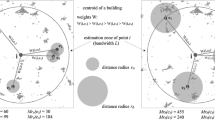Abstract
The objective of this paper is to show that morphological similarities between built-up urban surfaces are greater across borders than within cities in Europe: living, architectural and planning trends are international. The spatial arrangement of built-up areas is analysed here by means of fractal indices using a set of 97 town sections selected from 18 European urban agglomerations. The fractal dimension is estimated by correlation techniques. Results confirm that morphological similarities are higher across countries/cities than within. Moreover, two types of fractal laws are considered: one uses the basic fractal scaling law; the other introduces a prefactor a that is often called a “form factor” in the fractal literature. Differences in the results obtained by both laws are explained empirically as well as theoretically, and suggestions are made for further measurements.








Similar content being viewed by others

Notes
This freeware program has been developed by Frankhauser, Vuidel and Tannier and may be downloaded on the website (http://www.fractalyse.org/). The original version of this software has been developped in the frame of the French research program “Ville émergente” financed by the PUCA (Plan Urbanisme–Construction–Architecture).
References
Appleby S (1996) Multifractal characterization of the distribution pattern of the human population. Geogr Anal 28(2):147–160. doi:10.1023/A:1019149015867
Arlinghaus S, Arlinghaus W (1989) The fractal theory of central place geometry: a Diophantine analysis of fractal generators for arbitrary Loschian numbers. Geogr Anal 21(2):103–121
Badariotti D (2005) Des fractales pour l’urbanisme ? Quelques pistes de réflexion à partir de l’exemple de Strasbourg-Kehl. Revue de Géographie du Québec 49(137):133–256
Batty M (1991) Cities as Fractals: simulating growth and form. In: Earnshaw RA (ed) Fractals and Chaos. Springer, New York, pp 41–69
Batty M (2005) Cities and Complexity: Understanding Cities with Cellular Automata, Agent-Based Models and Fractals. The MIT Press, Cambridge, MA
Batty M, Longley P (1994) Fractal Cities. Academic Press, New York
Batty M, **e Y (1996) Preliminary evidence for a theory of the fractal city. Environ Plan 28A(10):1745–1762. doi:10.1068/a281745
Benguigui L, Czamanski D, Marinov M, Portugali Y (2000) When and where is a city fractal? Environ Plan 27B(4):507–519. doi:10.1068/b2617
Carvalho R, Penn A (2004) Scaling and universality in the micro-structure of urban space. Physica-A 332(1):539–547. doi:10.1016/j.physa.2003.10.024
Cavailhès J, Frankhauser P, Peeters D, Thomas I (2004) Where Alonso meets Sierpinski: an urban economic model of a fractal metropolitan area. Environ Plan A 36(8):1471–1498. doi:10.1068/a36126
Corbusier Le (1971) La charte d’Athènes—1933–1942. Seuil, Paris
De Keersmaecker M-L, Frankhauser P, Thomas I (2003) Using fractal dimensions to characterize intra-urban diversity: the example of Brussels. Geogr Anal 35(4):310–328. doi:10.1353/geo.2003.0014
Fotheringham A, Batty M, Longley P (1989) Diffusion-limited aggregation and the fractal nature of urban growth. Pap Reg Sci Assoc 67(1):55–69. doi:10.1007/BF01934667
Frankhauser P (1994) La fractalité des structures urbaines. Anthropos, Collection Villes, Paris
Frankhauser P (1998) The fractal approach: a new tool for the spatial analysis of urban agglomerations. Popul Engl Sel 10(1):205–240
Frankhauser P (ed) (2003) Morphologie des Villes Emergentes en Europe à travers les analyses fractales. Rapport de Recherche 2000–2003. PUCA (France), Ministère de l’Equipement, des Transports et du Logement. Pdf version in French: http://thema.univ-fcomte.fr
Frankhauser P (2008) Fractal geometry for measuring and modelling urban patterns. In: Albeverio S, Andrey D, Giordano P, Vancheri A (eds) The dynamics of complex urban systems: an interdisciplinary approach. Springer, New York, pp 241–243
Frankhauser P, Houot H, Tannier C, Vuidel G (2008) Vers des déplacements périurbains plus durables: propositions de modèles fractals opérationnels d’urbanisation. Report PREDIT, project 05MT5020, 114 p
Goodchild M, Mark D (1987) The fractal nature of geographic phenomena. Ann Assoc Am Geogr 77(2):265–278. doi:10.1111/j.1467-8306.1987.tb00158.x
Gouyet J-F (1992) Physique et structures fractales. Masson, Paris
Lagarias A (2007) Fractal analysis of the urbanization at the outskirts of the city: models, measurement and explanation. Cybergeo, Article 391
Lam N, De Cola L (eds) (2002) Fractals in Geography. The Blackburn Press, Caldwell, NJ
Longley P, Batty M (1989) On the fractal measurement of geographical boundaries. Geogr Anal 21(1):47–67
MacLennan M, Fotheringham S, Batty M, Longley P (1991) Fractal geometry and spatial phenomena. A Bibliography. NCGIA report 91–1, 53 p
Mandelbrot B (1982) The fractal geometry of nature. Freeman, San Francisco
Mattila P (1995) Geometry of sets and measures in Euclidean spaces: fractals and rectifiability. Cambridge University Press, Cambridge
Qin Y, Liu K (2004) Advances in applied studies of fractal theory in geography in China. J Geogr Sci 14(1):62–68. doi:10.1007/BF02841109
Salingaros N (2003) Connecting the fractal city. Keynote speech, Biennial of towns and town planners in Europe (Barcelona). http://zeta.math.utsa.edu/~yxk833/connecting.html
Schweitzer F, Steinbrink J (1998) Estimation of megacity growth: simple rules versus complex phenomena. Appl Geogr 18(1):69–81. doi:10.1016/S0143-6228(97)00047-7
Shen G (2002) Fractal dimension and fractal growth of urbanized areas. Int J Geogr Inf Sci 16(5):419–437. doi:10.1080/13658810210137013
Sun W, Xu G, Gong P, Lian S (2006) Fractal analysis of remotely sensed images: a review of methods and applications. Int J Remote Sens 27(2):4963–4990. doi:10.1080/01431160600676695
Tannier C, Pumain D (2005) Fractales et géographie urbaine: aperçu théorique et application pratique. Cybergeo, article 307
Thomas I, Frankhauser P, De Keersmaecker M-L (2007) Fractal dimension versus density of the built-up surfaces in the periphery of Brussels. Pap Reg Sci 86(2):287–307. doi:10.1111/j.1435-5957.2007.00122.x
Thomas I, Frankhauser P, Biernacki C (2008a) The fractal morphology of the built-up landscape. Landsc Urban Plan 84:99–115. doi:10.1016/j.landurbplan.2007.07.002
Thomas I, Tannier C, Frankhauser P (2008b) Is there a link between fractal dimension and residential choice at a regional level? Cybergeo, article 413
Vanneste D, Thomas I, Vanderstraeten L (2008) The spatial structure(s) of the Belgian housing stock. J Housing Built Environ 23(3):173–198. doi:10.1007/s10901-008-9111-3
White R, Engelen G (1993) Cellular automata and fractal urban form: a cellular modelling approach to the evolution of urban land use patterns. Environ Plan A 25(8):1175–1199. doi:10.1068/a251175
Author information
Authors and Affiliations
Corresponding author
Rights and permissions
About this article
Cite this article
Thomas, I., Frankhauser, P. & Badariotti, D. Comparing the fractality of European urban neighbourhoods: do national contexts matter?. J Geogr Syst 14, 189–208 (2012). https://doi.org/10.1007/s10109-010-0142-4
Received:
Accepted:
Published:
Issue Date:
DOI: https://doi.org/10.1007/s10109-010-0142-4



